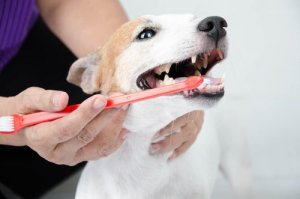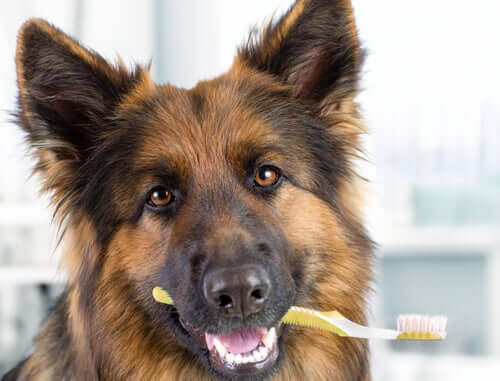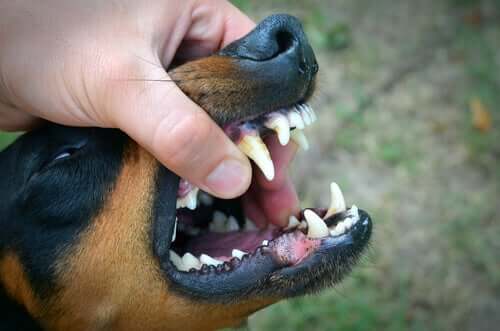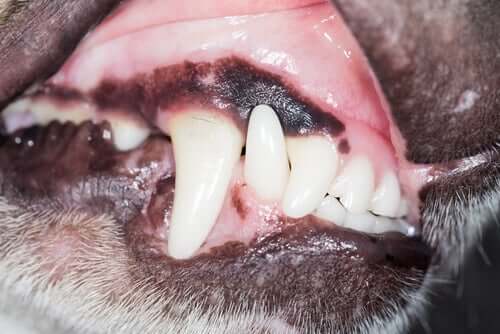Brushing a Dog's Teeth - Six Common Mistakes

Brushing a dog’s teeth is important because mouth disorders such as cavities, sore gums, and bad breath are no more normal or acceptable in dogs than they are in humans. We must emphasize, canine dental problems aren’t something an owner should ignore and neglect. If you have a dog then you should know the proper care they require in order to prevent health problems.
In addition, brushing is a good habit that reduces the need for invasive and expensive sedative dental procedures. So, in today’s article, we’ll tell you about six of the most common mistakes owners make while brushing their dog’s teeth and ways to correct them.
1. Improper tools for brushing a dog’s teeth
Most people who brush their dog’s teeth use a toothbrush and toothpaste specially designed for dogs. The former is tasty to a canine, as per its design.
It’s important to acquire the right type of toothbrush for your dog’s mouth. You should never use a human brush. The various shapes and sizes of snout require different types of brushes. For instance, you must keep in mind that a Chihuahua and an English bulldog are completely different.
You must follow your vet’s advice given the variety of toothbrushes and toothpaste options currently on the market. If you ask them, they’ll also show you how to correctly brush your dog’s teeth.
2. Relying only on the toothpaste when brushing a dog’s teeth

Are you aware that toothpaste for humans isn’t only inappropriate for dogs, but that they also hate the taste? Its use will make the brushing procedure rather unpleasant for the dog and it’s also highly ineffective.
However, even if you use a toothpaste suitable for dogs, you may still not obtain the best result. This is because it’s the act of brushing and not the toothpaste that’s key for protecting and thoroughly cleaning a dog’s teeth.
In fact, it’s possible to brush your dog’s teeth effectively without using toothpaste at all. So, be aware that a quick brush with toothpaste in your dog’s mouth won’t be effective.
3. Inconstancy when brushing dogs teeth
Being consistent with your dog’s teeth is the only means to achieve a positive impact on their dental health and avoid any future dental problems. You must internalize the fact that simply brushing your dog’s teeth from time to time isn’t enough.
Veterinarians recommend brushing a dog’s teeth at least three or four times a week, though once a day ideally.
For this reason, you must incorporate it into your usual routine. Not only because it’ll provide the best level of protection to your dog’s denture, but it’ll also help them get used to it. The procedure will be a lot simpler for you and stop being a major nuisance to both as soon as your dog agrees to it.
4. Not praising or rewarding

Even if your dog is very submissive when you brush their teeth, remember you’re asking them to submit to something that’s quite unusual for them, and out of their nature.
It’s for this reason that you must remain cheerful with your dog throughout the procedure. When you’re done, praise and reward them with their favorite toy, a song or just with a pat on their back.
5. Start dental care after problems arise
If your dog is already afflicted by bad breath, black gums, visible plaque, tooth decay, or tooth damage, then brushing their teeth won’t correct these problems.
You should know that if your dog’s mouth is not in good condition when you begin brushing their teeth, then their problems won’t go away. In fact, the act of brushing could even be unpleasant or even painful for your dog at such an advanced stage of oral damage.
Instead, your dog must undergo a veterinary dental procedure under sedation to address any existing problems. Only afterward will it be a good idea to start brushing their teeth at home.
In conclusion, the mere act of brushing your dog’s teeth when there’s already damage won’t prevent further problems.
6. Ignoring the dog’s oral problems

Finally, brushing your dog’s teeth is an excellent opportunity to keep an eye on their teeth and gums. Only then will you be able to identify what’s normal and quickly detect any existing problem.
It goes without saying that prevention is only effective if you take action as soon as you detect a potential problem. So, take your dog to the vet as soon as possible if you notice any anomalies.
Dental problems can arise even in dogs whose teeth are cleaned regularly. As you can see, you can’t entirely avoid these kinds of problems by brushing alone.
However, prompt intervention and attention to dental problems will ensure the good health of your dog’s mouth. So, take care of it from an early age and you’ll only need minimal extra treatments.
In conclusion, oral disorders happen to the best of brushers. There are many mistakes you’re probably making when brushing your dog’s teeth. So try to identify and correct them – it’ll surely have a positive impact on your animal’s well-being.
All cited sources were thoroughly reviewed by our team to ensure their quality, reliability, currency, and validity. The bibliography of this article was considered reliable and of academic or scientific accuracy.
- Sanabria, E, & Vázquez, G., (2004). Manual de profilaxis dental en perros. Centro universitario de ciencias biológicas y agropecuarias. División de ciencias veterinarias. Universidad de guadalajara.
- Grandez, R., & Porras, C. (2013). Frecuencia de alteraciones dentales y periodontales en perros atendidos en la clínica veterinaria de la Universidad Peruana Cayetano Heredia durante mayo–octubre. Salud tecnol. vet. 2013; 1:14-18.
- Acheverreaga, F., & Burgueño, M. (2012). Prevalencia de la enfermedad periodontal en perros de Uruguay, determinación de su gravedad y de los posibles factores de riesgo. Universidad de la República (Uruguay). Facultad de Veterinaria.
This text is provided for informational purposes only and does not replace consultation with a professional. If in doubt, consult your specialist.